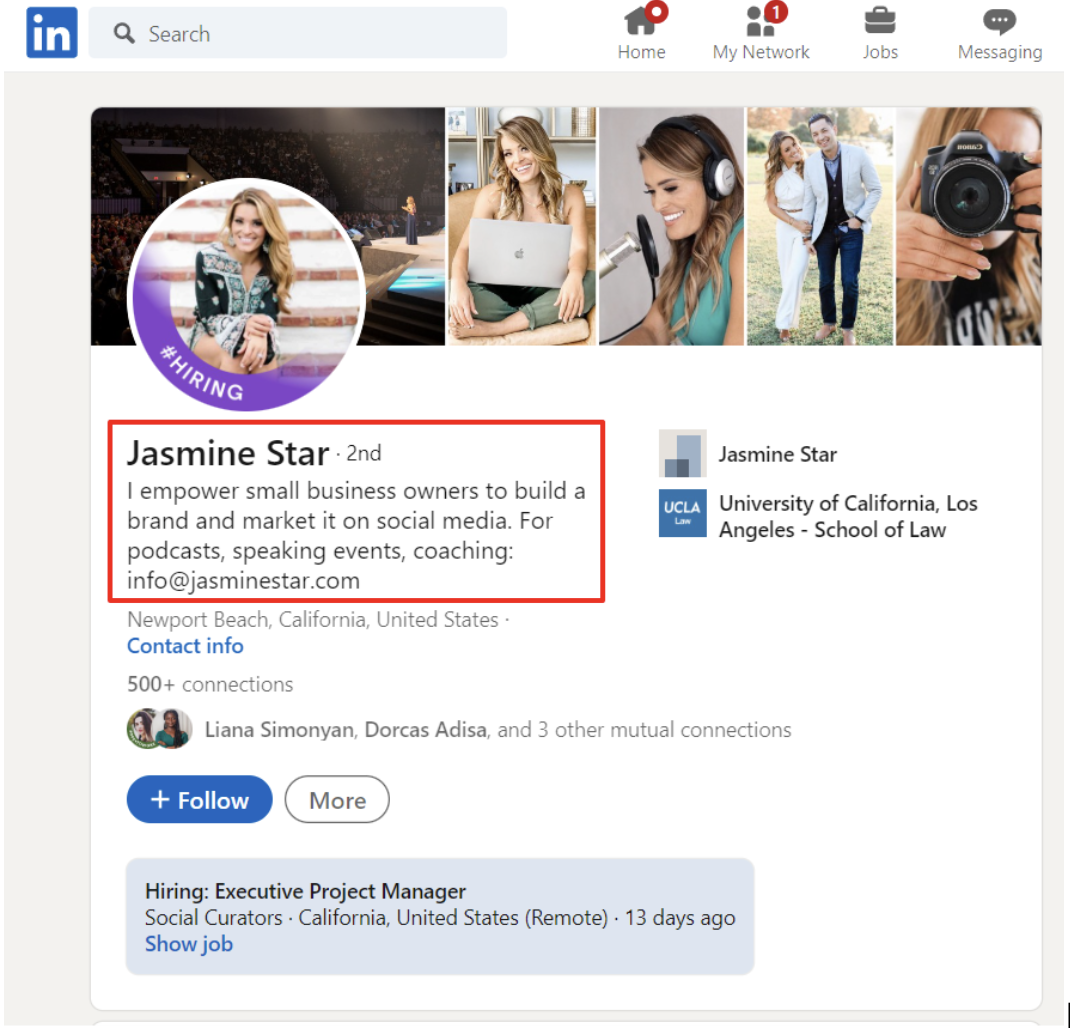Optimizing Digital Marketing Channels for B2B Success
Looking to make the most of your B2B digital marketing channels?
We’ve put together a quick and easy guide to help you optimize your channels for B2B marketing success.
Ready to learn more?
Let’s begin!
The importance of tailoring your approach to your target audience
Before we cover some of the best ways to optimize your channels, it's essential to keep in mind how crucial it is to tailor everything to your target audience.
By going the extra mile to optimize your online channels with your core audience in mind, you’ll not only help your audience feel seen, but you’ll also learn valuable insights on how to improve your business.
Think about it. If you were to design a virtual assistant platform for medical physicians and surgeons, over time, your channels would give you access to ongoing feedback and data, revealing how to best refine your software.
Social media users will comment about their favorite features or issues they’re running into when you post. Leads from your email marketing campaigns will reply with questions or concerns. And CS form inquiries will reveal some of the most common questions your customer base has.
In other words, optimizing your digital marketing channels for B2B success is a win-win strategy. It shows your audience that you can solve their problems, and, in turn, you learn how to curate your business with them in mind.
Without further ado, let’s take a look at how to optimize your marketing channels.
Choose digital channels and strategies with your target audience in mind
In a 2022 survey by Statista, it was found that social media was the most popular digital marketing channel for B2B marketers, followed by website/blog, email marketing, and content marketing.
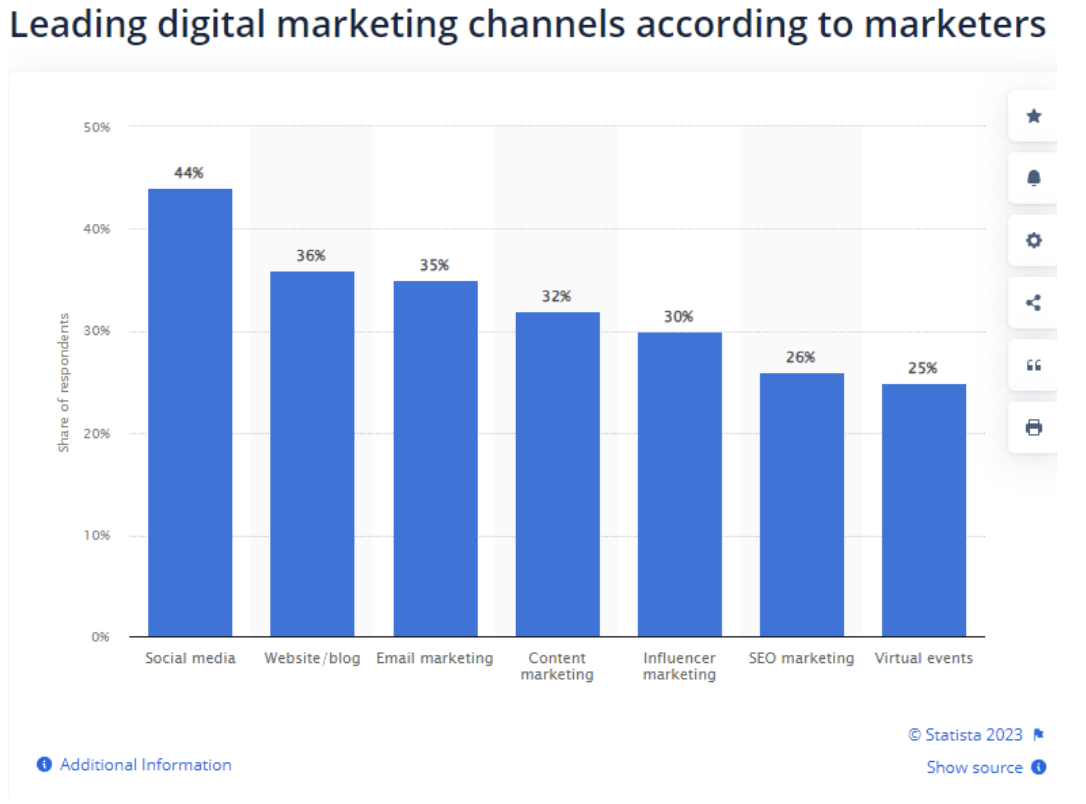
However, the channels you choose to primarily focus on should depend on where your core audience lives online and what your business and marketing goals are.
For instance, many B2B SaaS businesses find a ton of success with content marketing since it focuses on bringing potential customers to you rather than going out and finding them yourself. Content marketing also helps SaaS companies nurture leads and move them through the sales funnel. Many B2B ecommerce brands, on the other hand, find success with email marketing.
To solidify your channels and strategies, consider sending polls to your target audience to uncover where they live online and what they best respond to. You can also conduct competitor research to see which channels and strategies brands in your industry are using.
Here are some examples of common B2B marketing channels and strategies:
- LinkedIn, YouTube, and Facebook
- Email marketing
- Guest posting
- Content marketing
- Link building
- Funnel marketing
- Optimized website/blog
- B2B directory presence
- Video marketing
- In-person, virtual, and hybrid events
- Thought leadership content
- Referral marketing
- Influencer marketing
Optimize your social media profiles
Once you know which social media platforms to target, refer to your digital marketing strategy, brand goals, and audience to optimize each profile. Your social media marketing plan should nestle into your overall strategy.
For instance, if part of your strategy is lead generation, then you’ll need to consider how to plan social media posts that attract and encourage prospects to give you their contact details. (More on this in a bit.)
Here are some additional ways you can optimize your social media profiles:
Brand what you can: Add your logo to your visuals; Use branded Story templates
Add an engaging profile picture: Choose an image that clearly shows what you do, who you help, and/or what you sell; When in doubt, use your company logo; Add branded header images...
Write value-focused bios tailored to your B2B audience (make sure to provide a link for your CTA): Try the PAS framework plus a call-to-action (CTA) - Example: “Got low productivity and disengaged employees? Download our free productivity guide”; Share who you help and how, plus a CTA - Example: “We help pms save 10+ hours a week planning projects — start your free trial today!”
Ask the audience a pain point question and provide a solution: "Need fast delivery? We offer same-day trucking and overnight delivery services. Get a quote or book your delivery today!"
Implement a strategic B2B content marketing plan
As we touched on previously, content marketing focuses on bringing potential customers to you so you don’t have to go out and find them yourself. This makes it an excellent channel for B2B brands. In this matter, a B2B SEO rank tracker becomes indispensable to monitor and measure the effectiveness of your content strategies, enabling you to refine your approach.
Not only can content marketing help you build a powerful online presence, but it’s also a crucial pillar in search engine marketing, as Google values businesses that publish high-quality content for their niche audiences.
If you don’t currently have an SEO strategy, consider locking arms with an agency or consultant that specializes in SEO. They can either produce or help you learn how to create relevant content for your ideal customer using AI writing tools. Simply detail your target audience’s pain points and the solutions you offer so they can research and focus on the right topics and keywords.
When planning your approach, be sure to strategize content for:
- Your website, i.e., content you can publish in your: Blog posts, Help Center, FAQ section, Knowledge Base, Product/service pages...
- High authority sites, for instance: Guest posting pitches, Link-building opportunities, Collabs, and partnership opportunities...
- Your social media profiles, such as: Visual assets (think video content, static images, infographics, and carousel images, for example), Story content, i.e., behind-the-scenes content, polls, and video snippets, Written content, such as tips, advice, thought leadership content, demand gen content, and lead gen content
Again, never publish content unless it’s relevant, high-quality, and valuable to your ideal customer.
All of your content assets should pass the following checklist questions:
- Is this content tailored to our target audience?
- Does our audience need this information?
- Would our audience find this information useful or helpful?
- Would our audience walk away with value after consuming this content?
- Could this asset help us build meaningful connections with our audience?
- Is this asset grounded in expertise, authority, and experience?
- Is this asset based on search intent?
- Does this asset serve our overarching SEO strategy?
- Could this asset help us build authority in our niche?
- Could this asset nudge lead closer to conversion?
- Can this asset help us meet our marketing goals?
If you answered yes to the above questions, you’ve got quality content on your hands!
For instance, the following guide on multi-factor authentication by FusionAuth is a fantastic example of high-value content that’s tailored to its audience’s needs and pain points. It ticks all of the above boxes and is optimized for SEO:
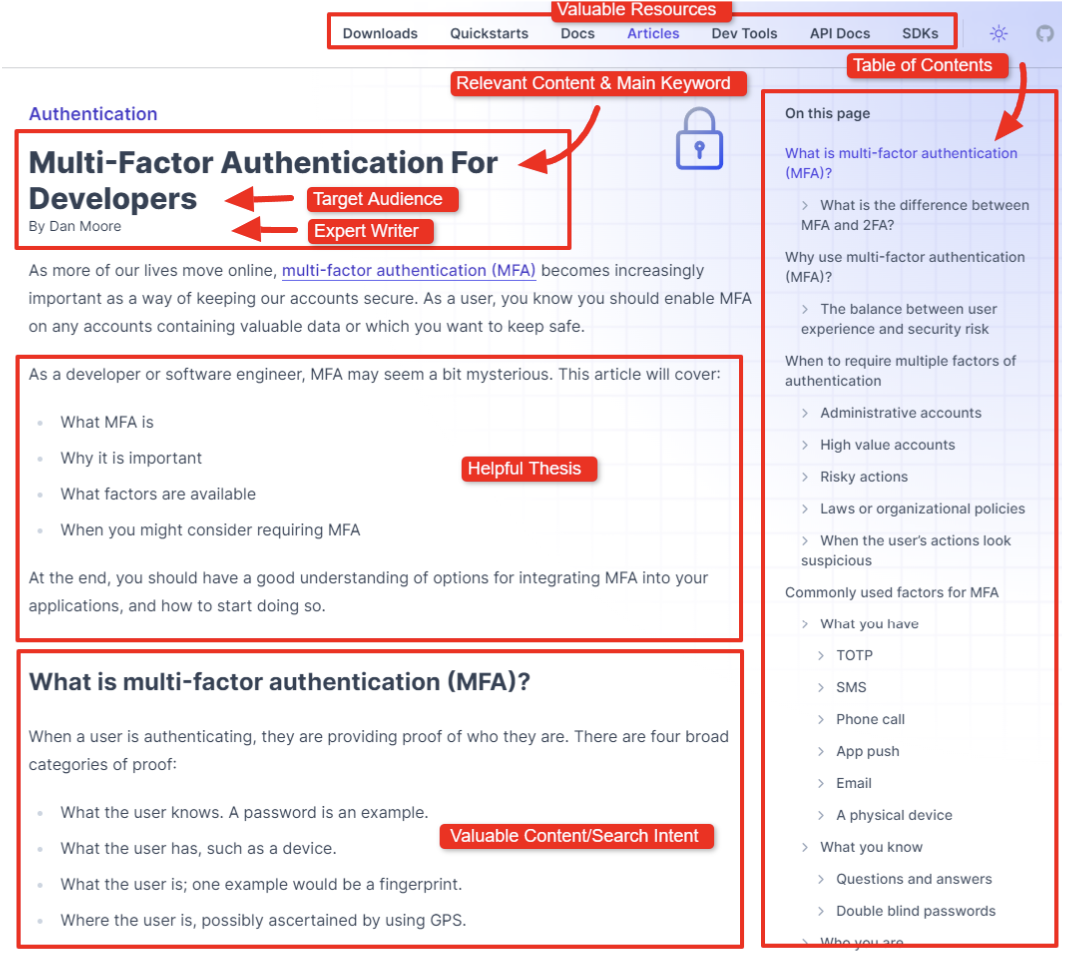
FusionAuth also offers a directory, resource links, and a search bar in case readers want to check out additional topics.
Support the customer journey by optimizing your marketing funnels
Cater to customer touch points and influence purchasing decisions by optimizing your B2B marketing funnels.
Your goal? Choosing irresistible lead magnets (make sure you’re choosing options that you know your audience would want/appreciate) and building high-converting landing pages.
Once you’ve got the opt-in, supplying what you promised is the easy part!
A simple trick to uncovering lead magnets your audience would love is to look back on previous posts and articles with high customer engagement, common CS questions, and social media brand mentions for clues and suggestions. You can also conduct behavior research and send out polls and surveys.
For instance, if website visitors and social media users often ask if you offer SAP consulting services, you might consider using the following lead magnets: Free tickets to a webinar that covers your consultation process; A free ebook on SAP basics; A SAP consulting explainer video.
From here, you’ll need to create your landing pages with built-in opt-in forms. Remember, don’t skimp on your landing pages! You’ll need a lead magnet landing page and an additional landing page for prospects that are interested in taking things a step further by making a purchase.
On the lead magnet landing page, make the opt-in form short, sweet and to the point. For instance, don’t include too many fields — just add a spot for the prospect’s name and email address.
On the converting landing page, add a few more fields so you can grab pertinent information relevant to the sale, such as the new customer’s: Name; Email address; Phone number; Company name; Job title; Industry.
You might also consider adding a “Notes” field in case they have additional concerns or requests.
You’ll also want to make sure your converting landing page:
Targets specific products or services relevant to the lead magnet, such as the types of SAP consultations you offer
- Speaks to your target market’s concerns, i.e., shows that your consultants possess deep knowledge and experience in maximizing SAP capabilities
- Includes trust elements and/or social proof
- Showcases benefits of using your products or services
- Includes additional CTA buttons in case prospects miss the opt-in form
For instance, the following landing page ticks all of the boxes and has a great opt-in form:
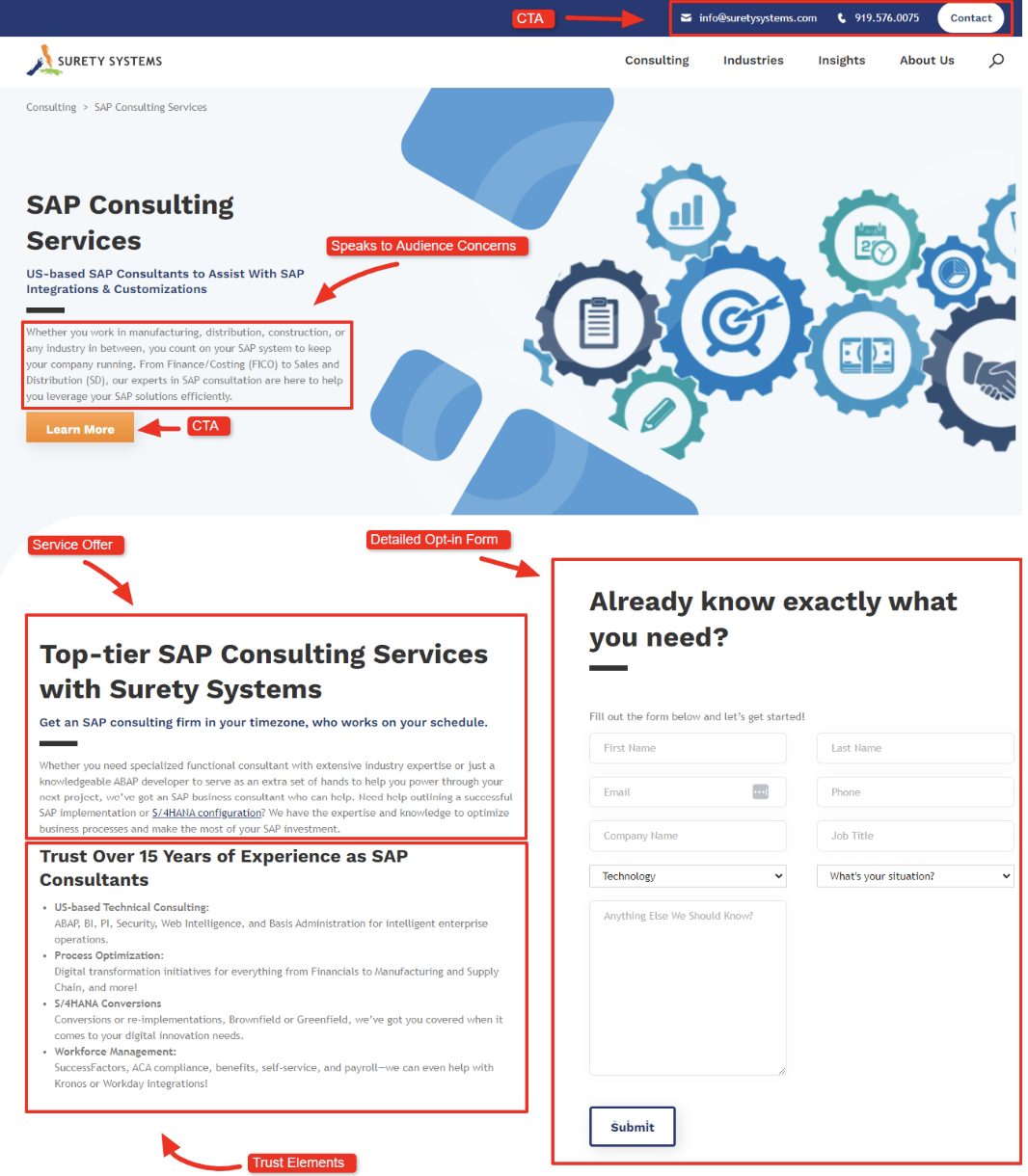
And if you scroll past the form, you’ll also notice specific SAP consulting service options:
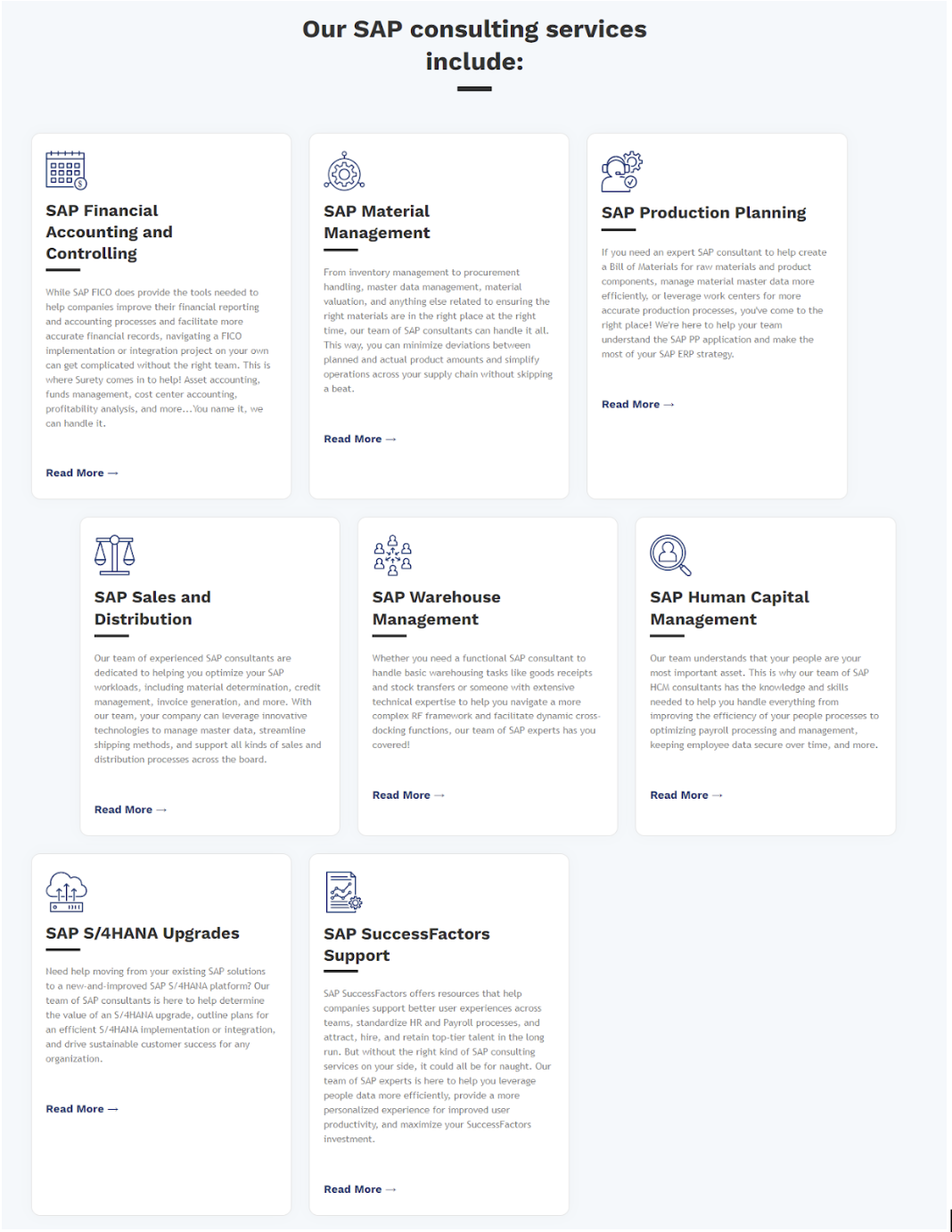
And if you scroll to the end, you’ll also notice a benefits section and an additional CTA button:
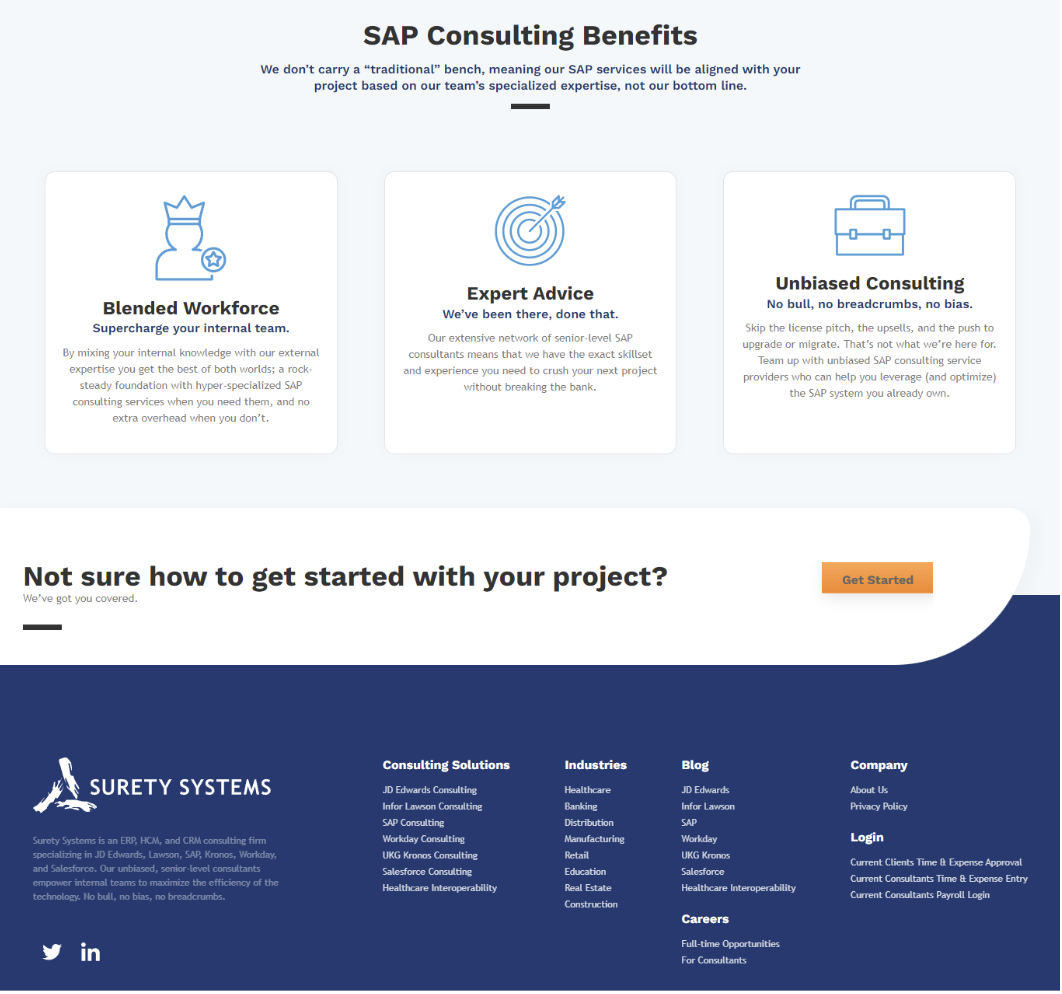
This goes without saying, but it’s also crucial to optimize your website for B2B success.
Tailor your site to your ideal customers by using strategic CTAs, pointed copy, and clear messaging about how to buy your products and services.
Your goal? Build your site to nurture visitors to conversion. Use social proof, trust elements, engaging visuals, and value-driven copy to demonstrate that your solutions will take care of your audience’s problems better than your competitors’ solutions can.
Pro-Tip: Attract more qualified leads to your website by locking arms with B2B affiliate marketers that serve your niche audience. You’ll only have to pay them if their referrals make a purchase!
Wrap up
Optimizing your marketing channels for B2B success is a simple process if you keep your target customer in mind.
By tailoring your online presence to their needs, thoughts, and preferences, you’ll create an engaging experience that helps you nurture qualified leads to conversion.
If you’re ready to revamp your online channels, bookmark and print this article for reference — and don’t forget to share it with your marketing team!
That’s it for now.
Here’s to your success!
PS: Need to create powerful lead forms that can help you win more customers and grow your business? Gain a competitive advantage with our high-converting lead forms. Start your free LeadGen App trial today — no credit card required.

